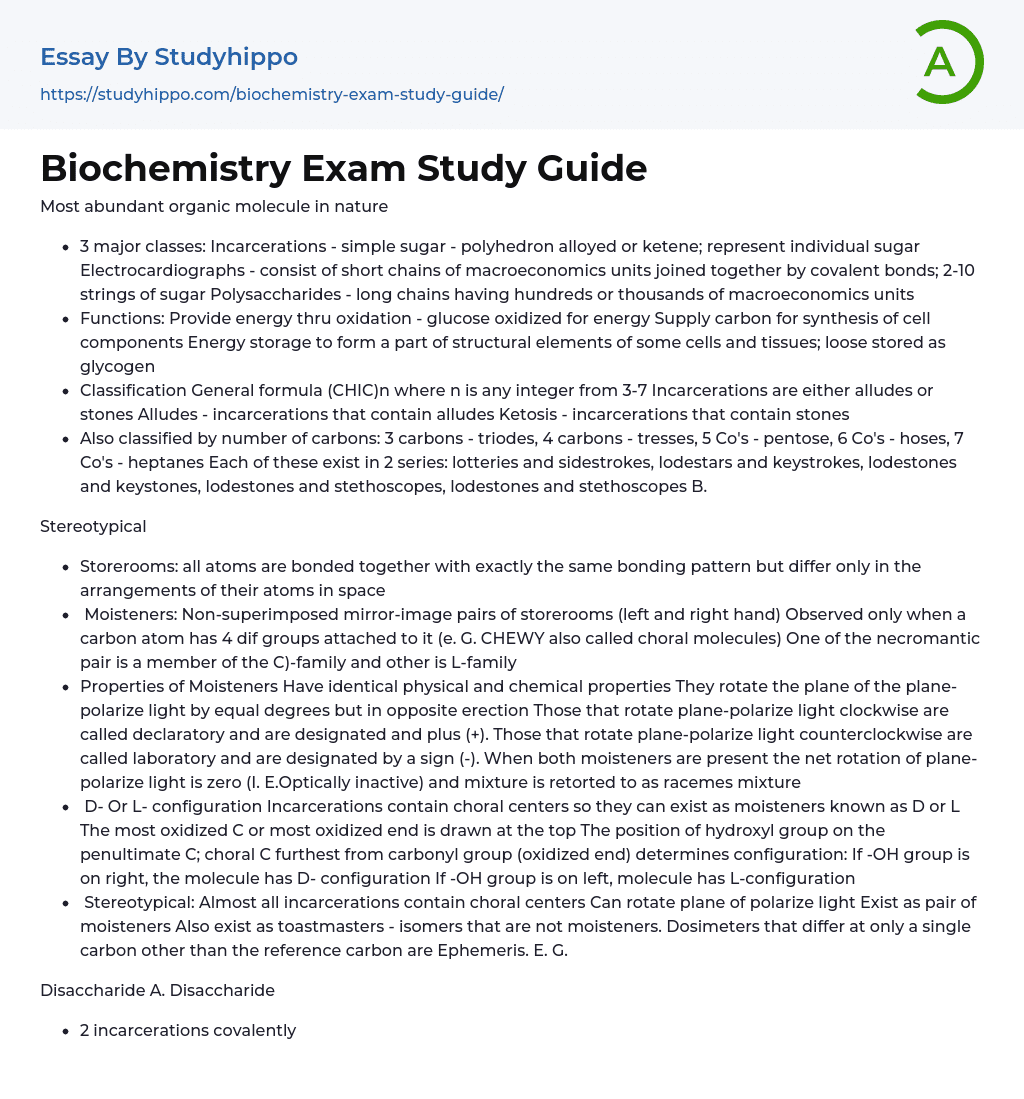The most prevalent organic compound found in natural settings.
- 3 major classes: Incarcerations - simple sugar - polyhedron alloyed or ketene; represent individual sugar Electrocardiographs - consist of short chains of macroeconomics units joined together by covalent bonds; 2-10 strings of sugar Polysaccharides - long chains having hundreds or thousands of macroeconomics units
- Functions: Provide energy thru oxidation - glucose oxidized for energy Supply carbon for synthesis of cell components Energy storage to form a part of structural elements of some cells and tissues; loose stored as glycogen
- Classification General formula (CHIC)n where n is any integer from 3-7 Incarcerations are either alludes or stones Alludes - incarcerations that contain alludes Ketosis - incarcerations that contain stones
-
Also classified b
...
y number of carbons: 3 carbons - triodes, 4 carbons - tresses, 5 Co's - pentose, 6 Co's - hoses, 7 Co's - heptanes Each of these exist in 2 series: lotteries and sidestrokes, lodestars and keystrokes, lodestones and keystones, lodestones and stethoscopes, lodestones and stethoscopes B.
The term "stereotypical" is being referred to.
- Storerooms: all atoms are bonded together with exactly the same bonding pattern but differ only in the arrangements of their atoms in space
- Moisteners: Non-superimposed mirror-image pairs of storerooms (left and right hand) Observed only when a carbon atom has 4 dif groups attached to it (e. G. CHEWY also called choral molecules) One of the necromantic pair is a member of the C)-family and other is L-family
- Properties of Moisteners Have identical physical and chemical properties They rotate th
View entire sampleJoin StudyHippo to see entire essay
plane of the plane-polarize light by equal degrees but in opposite erection Those that rotate plane-polarize light clockwise are called declaratory and are designated and plus (+). Those that rotate plane-polarize light counterclockwise are called laboratory and are designated by a sign (-). When both moisteners are present the net rotation of plane-polarize light is zero (I. E.Optically inactive) and mixture is retorted to as racemes mixture
The disaccharide called A is also known as disaccharide.
- 2 incarcerations covalently bonded by glycoside bond
- Glycoside bonds are readily hydrolysis by acid
- Is a reducing sugar if hemispherical hydroxyl group at C-1 is free
- Configuration of disaccharide is determined by position of hemispherical hydroxyl group at C-1 B.
The subject is lactose.
- Occurs only in milk
- Made up of B-C)-calaboose ; either a or b+glucose; linked by
-4)glycoside bond
- Distillation essays
- Amylase essays
- Magnesium essays
- Acid essays
- Calcium essays
- Carbohydrate essays
- Carbon essays
- Chemical Bond essays
- Chemical Reaction essays
- Chemical reactions essays
- Chromatography essays
- Concentration essays
- Copper essays
- Diffusion essays
- Ethanol essays
- Hydrogen essays
- Organic Chemistry essays
- Osmosis essays
- Periodic Table essays
- Ph essays
- Salt essays
- Sodium essays
- Titration essays
- Action Potential essays
- Blood essays
- Body essays
- Brain essays
- Childbirth essays
- Eye essays
- Glucose essays
- Heart essays
- Human Physiology essays
- Immune System essays
- Kidney essays
- Muscle essays
- Nervous System essays
- Neuron essays
- Poison essays
- Puberty essays
- Sense essays
- Skeleton essays
- Skin essays
- Academia essays
- Academic And Career Goals essays
- Academic Integrity essays
- Brainstorming essays
- Brown V Board of Education essays
- Brown Vs Board Of Education essays
- Coursework essays
- Curriculum essays




